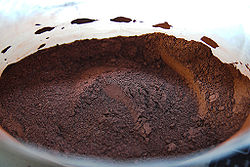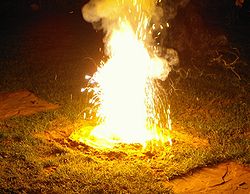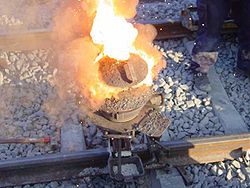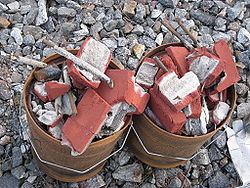Thermite
| Thermite | |
|---|---|

|
Thermite is a mixture in which aluminum is oxidized by another metal, commonly iron oxide, producing an exothermic reaction. This reaction is classified as an aluminothermic reaction or thermite reaction. Although it is not expl]]osive, it can produce intense heat. When captured this heat is quiet useful in many industries around the world. Also it has proved to be a essential weapon through World War II. [1]
Properties
The basic thermite compound consists of iron oxide and aluminum. Although other [oxides] are available to use, but the iron oxide still remains the best. This is also true for the aluminum, due to its reactive nature it is oxidized very quickly. [2] Another favorable property of aluminum is its low boiling point. This low boiling point provides a low ignition temperature for the reaction, but on the other hand its high boiling point provides the reaction space to achieve very high temperatures. [3] Both properties of these metals are stable at room temperature together, but when intense heat is exposed to the mixture a exothermic reaction takes place. As a result temperatures of the reaction can reach upwards of 2500 degrees C. As this reaction takes place oxygen is produced thus resulting in an inability to be put out.
History
The thermite reaction was first introduced in 1893, by a German chemist Dr. Hans Goldschmidt, which was later patented in 1895. [4] However, the real intentions of his invention were to be used as an aid to avoid the use of the carbon smelting process. As this smelting process, would commonly used carbon, which would not produce a highly purified metal. After numerous tests of the initial invention of thermit, it was reengineered to be used in the welding of tram tracks in Essen, Germany in 1899. As a result of this invention sparked the ideas of welding with thermit which became a successful procedure used by many railroad companies. [5] As a result the largest producer of welding thermit still remains the Goldschmidt firm. [6]
Uses
Civilian Uses
Due to thermite’s incendiary properties it opens up an ample spectrum of uses. As a result one of the most common uses of thermit is in welding. It is most commonly used to weld railroad rails together. [7] In addition it was used to cut through thick sheets of metal. Its popularity was due to its simplicity. While many other welding and cutting equipment used very sophisticated and heavy machinery, thermite was relatively simple and lightweight. [8] Although these uses were not the original intentions of the creator, they have proved to be quiet useful. However, thermit was originally used to purify the ores metals. This process of using thermite is called the Thermite process or the Goldschmidt process. [9] Although thermite proved to be an essential produce it had some drawbacks. For instance, when it was used to weld railroad rails together it often left behind a slag, which was needed to be chipped off. When this slag was removed it often left behind impurities, such as holes and unevenness throughout the weld. As a result great care was needed in order to insure the safety of the train. [10]
Military Uses
In the military field thermite is used as an incendiary device. However, it is not used alone, but it is often mixed with other pyrotechnic additives. This addition serves the purposed to simplify the ignition process. In addition these additives increase the damage radius, thus resulting in more destruction. [11] The most common mixture used by the military consists of general thermite 68.7%, barium nitrate 20.0%, sulfur 2%, and binder 0.3%. [12] The addition of these material increase the damage radius, but the major drawback is the reduce reaction heat. One of the most common use of thermite in the military field is in a grenade. The World War II era proved the effectiveness of the thermite. Often it was used to destroy enemy artillery and weapons in a stealthy manor. This was seen during the invasion of Normandy against the Nazi forces. It was forced down the muzzle of artillery, rendering the barrel ineffective. Also it was used to quickly destroy weapons that were in danger of being captured by enemy forces. These tactics and uses of thermite for the military application proved to be a vital weapon of destruction. [13]
Thermite Welding
One of the most important uses of thermite is for welding. This process is often called thermite welding (TW) or thermit welding. This process does not require any pressure, but it is based purely on the heat. This super heat evolves from the exothermic reaction between the iron oxide and the aluminum. Another benefit of welding with thermite is simplicity of the equipment. Most commonly a magnesium-lined crucible is used for holding the thermite mixture. At the bottom there is a small thimble used to discharge the thermite and at the bottom of the crucible is a magnesium rock used as the igniter for the thermite. After the pieces of metal that are to be welded are aligned a wax mold is placed around the joints and then a refractory sand mold is built around the wax. Then the sand mold is heated to welding temperatures, evaporating the wax and moister. Once this is completed the thermite is ignited and after approximately twenty to thirty second the weld is completed. After the weld has cooled the slag is chipped off and the weld is examined. Once the weld has qualified based on the requirements the weld is smoothed out. [14]
References
- Thermite Welding Weld Procedures Article Directory.
- Thermite General Facts chemistrydaily.com.
- Thermite General Facts Cambridge Encyclopedia, encyclopedia.stateuniversity.com
- Thermite summary bookrags.com
- Thermite Uses search.com
Video
| ||||||||||||||



